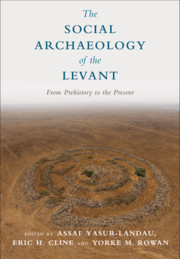Book contents
- The Social Archaeology of the Levant
- The Social Archaeology of the Levant
- Copyright page
- Contents
- Figures
- Tables
- Contributors
- Foreword
- Acknowledgments
- Abbreviations
- Prologue
- Part One
- Part Two
- Nine The Southern Levant during the Early Bronze Age I–III
- Ten Continuity, Innovation, and Change
- Eleven Mix ‘n’ Match
- Twelve The Middle Bronze Age Canaanite City as a Domesticating Apparatus
- Thirteen Cuneiform Writing in Bronze Age Canaan
- Fourteen “Canaan Is Your Land and Its Kings Are Your Servants”
- Part Three
- Part Four
- Part Five
- Part Six
- Epilogue
- Index
- References
Nine - The Southern Levant during the Early Bronze Age I–III
from Part Two
Published online by Cambridge University Press: 14 December 2018
- The Social Archaeology of the Levant
- The Social Archaeology of the Levant
- Copyright page
- Contents
- Figures
- Tables
- Contributors
- Foreword
- Acknowledgments
- Abbreviations
- Prologue
- Part One
- Part Two
- Nine The Southern Levant during the Early Bronze Age I–III
- Ten Continuity, Innovation, and Change
- Eleven Mix ‘n’ Match
- Twelve The Middle Bronze Age Canaanite City as a Domesticating Apparatus
- Thirteen Cuneiform Writing in Bronze Age Canaan
- Fourteen “Canaan Is Your Land and Its Kings Are Your Servants”
- Part Three
- Part Four
- Part Five
- Part Six
- Epilogue
- Index
- References
- Type
- Chapter
- Information
- The Social Archaeology of the LevantFrom Prehistory to the Present, pp. 163 - 182Publisher: Cambridge University PressPrint publication year: 2018
References
- 2
- Cited by

